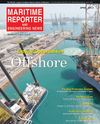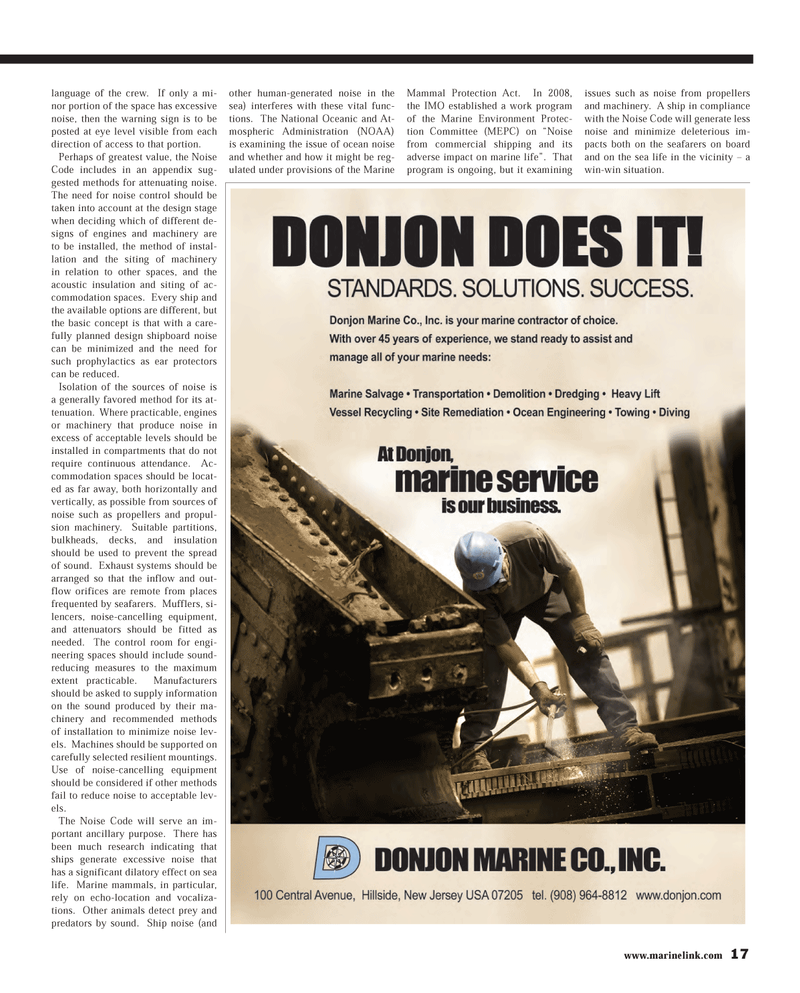
Page 17: of Maritime Reporter Magazine (April 2013)
Offshore Energy Edition
Read this page in Pdf, Flash or Html5 edition of April 2013 Maritime Reporter Magazine
www.marinelink.com 17language of the crew. If only a mi- nor portion of the space has excessive noise, then the warning sign is to be posted at eye level visible from each direction of access to that portion. Perhaps of greatest value, the Noise Code includes in an appendix sug-gested methods for attenuating noise. The need for noise control should be taken into account at the design stage when deciding which of different de- signs of engines and machinery are to be installed, the method of instal-lation and the siting of machinery in relation to other spaces, and the acoustic insulation and siting of ac-commodation spaces. Every ship and the available options are different, but the basic concept is that with a care-fully planned design shipboard noise can be minimized and the need for such prophylactics as ear protectors can be reduced.Isolation of the sources of noise is a generally favored method for its at-tenuation. Where practicable, engines or machinery that produce noise in excess of acceptable levels should be installed in compartments that do not require continuous attendance. Ac- commodation spaces should be locat-ed as far away, both horizontally and vertically, as possible from sources of noise such as propellers and propul-sion machinery. Suitable partitions, bulkheads, decks, and insulation should be used to prevent the spread of sound. Exhaust systems should be arranged so that the inflow and out-flow orifices are remote from places frequented by seafarers. Mufflers, si- lencers, noise-cancelling equipment, and attenuators should be fitted as needed. The control room for engi- neering spaces should include sound-reducing measures to the maximum extent practicable. Manufacturers should be asked to supply information on the sound produced by their ma-chinery and recommended methods of installation to minimize noise lev-els. Machines should be supported on carefully selected resilient mountings. Use of noise-cancelling equipment should be considered if other methods fail to reduce noise to acceptable lev-els. The Noise Code will serve an im-portant ancillary purpose. There has been much research indicating that ships generate excessive noise that has a significant dilatory effect on sea life. Marine mammals, in particular, rely on echo-location and vocaliza-tions. Other animals detect prey and predators by sound. Ship noise (and other human-generated noise in the sea) interferes with these vital func-tions. The National Oceanic and At- mospheric Administration (NOAA) is examining the issue of ocean noise and whether and how it might be reg-ulated under provisions of the Marine Mammal Protection Act. In 2008, the IMO established a work program of the Marine Environment Protec-tion Committee (MEPC) on ?Noise from commercial shipping and its adverse impact on marine life?. That program is ongoing, but it examining issues such as noise from propellers and machinery. A ship in compliance with the Noise Code will generate less noise and minimize deleterious im-pacts both on the seafarers on board and on the sea life in the vicinity ? a win-win situation. MR #4 (10-17).indd 17MR #4 (10-17).indd 174/1/2013 1:48:45 PM4/1/2013 1:48:45 PM

 16
16

 18
18
